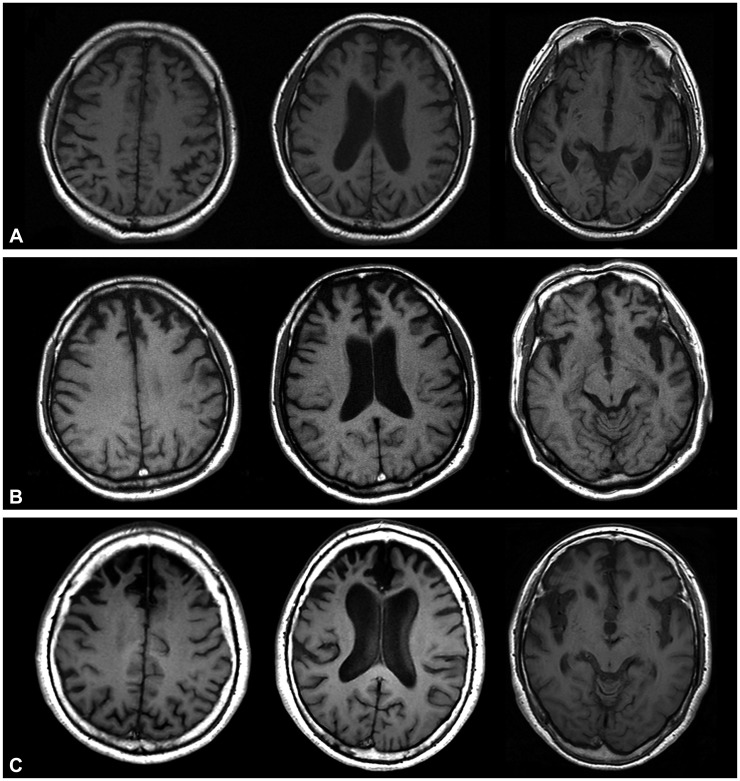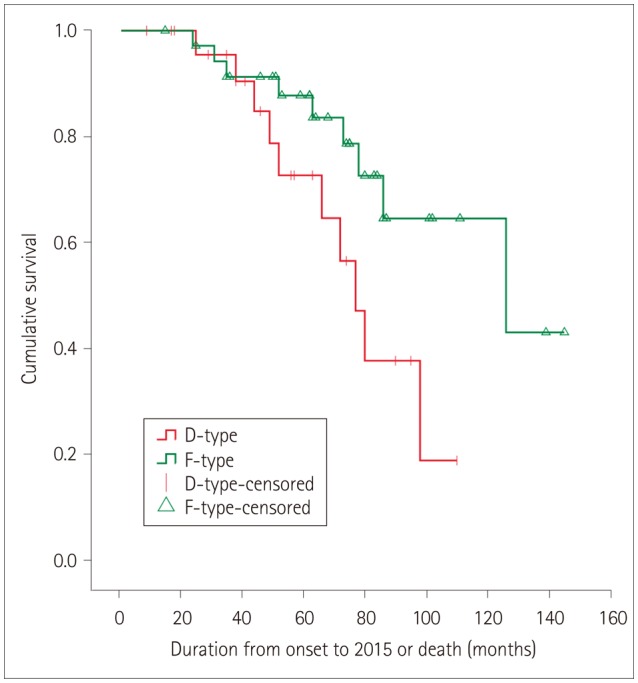J Clin Neurol.
2017 Jul;13(3):234-242. 10.3988/jcn.2017.13.3.234.
Prognosis of Patients with Behavioral Variant Frontotemporal Dementia Who have Focal Versus Diffuse Frontal Atrophy
- Affiliations
-
- 1Department of Neurology, Kyung Hee University Hospital, Seoul, Korea.
- 2Department of Neurology, Pusan National University Hospital, Pusan National University School of Medicine and Medical Research Institute, Busan, Korea.
- 3Department of Neurology, Samsung Medical Center, Sungkyunkwan University School of Medicine, Seoul, Korea. dukna@skku.edu
- 4Neuroscience Center, Samsung Medical Center, Seoul, Korea.
- 5Department of Clinical Research Design and Evaluation, SAIHST, Sungkyunkwan University, Seoul, Korea.
- 6Department of Health Sciences and Technology, SAIHST, Sungkyunkwan University, Seoul, Korea.
- 7Department of Neurology, Chungnam National University Hospital, Daejeon, Korea.
- 8Department of Neurology, Chuncheon Sacred Heart Hospital, Hallym University College of Medicine, Chuncheon, Korea.
- 9Department of Neurology, Asan Medical Center, University of Ulsan College of Medicine, Seoul, Korea.
- 10Department of Neurology, Chonnam National University Medical School, Gwangju, Korea.
- 11Department of Neurology, Dong-A Medical Center, Dong-A University College of Medicine, Busan, Korea.
- 12Department of Neurology, Eulji University Hospital, Eulji University School of Medicine, Daejeon, Korea.
- 13Department of Neurology, Ewha Womans University Mokdong Hospital, Ewha Womans University School of Medicine, Seoul, Korea.
- 14Department of Neurology, Seoul National University Bundang Hospital, Seongnam, Korea.
- 15Department of Neurology, College of Medicine, Hanyang University, Seoul, Korea.
- 16Department of Neurology, Mayo Clinic, Rochester, MN, USA.
- 17Stem Cell & Regenerative Medicine Institute, Samsung Medical Center, Seoul, Korea.
- KMID: 2391666
- DOI: http://doi.org/10.3988/jcn.2017.13.3.234
Abstract
- BACKGROUND AND PURPOSE
Only a few studies have investigated the relationship between different subtypes and disease progression or prognosis in patients with behavioral variant frontotemporal dementia (bvFTD). Since a localized injury often produces more focal signs than a diffuse injury, we hypothesized that the clinical characteristics differ between patients with bvFTD who show diffuse frontal lobe atrophy (D-type) on axial magnetic resonance imaging (MRI) scans versus those with focal or circumscribed frontal lobe atrophy (F-type).
METHODS
In total, 94 MRI scans (74 scans from bvFTD and 20 scans from age-matched normal controls) were classified into 35 D- and 39 F-type bvFTD cases based on an axial MRI visual rating scale. We compared baseline clinical characteristics, progression in motor and cognitive symptoms, and survival times between D- and F-types. Survival analyses were performed for 62 of the 74 patients.
RESULTS
While D-type performed better on neuropsychological tests than F-type at baseline, D-type had higher baseline scores on the Unified Parkinson's Disease Rating Scale (UPDRS) Part III. Evaluations of motor progression showed that the disease duration with motor symptoms was shorter in D-type than F-type. Moreover, the survival time was shorter in D-type (6.9 years) than F-type (9.4 years). Cox regression analyses revealed that a high UPDRS Part III score at baseline contributed to an increased risk of mortality, regardless of the pattern of atrophy.
CONCLUSIONS
The prognosis is worse for D-type than for those with F-type. Shorter survival in D-type may be associated with the earlier appearance of motor symptoms.
Keyword
MeSH Terms
Figure
Reference
-
1. Josephs KA, Hodges JR, Snowden JS, Mackenzie IR, Neumann M, Mann DM, et al. Neuropathological background of phenotypical variability in frontotemporal dementia. Acta Neuropathol. 2011; 122:137–153. PMID: 21614463.
Article2. Snowden JS, Bathgate D, Varma A, Blackshaw A, Gibbons ZC, Neary D. Distinct behavioural profiles in frontotemporal dementia and semantic dementia. J Neurol Neurosurg Psychiatry. 2001; 70:323–332. PMID: 11181853.
Article3. Whitwell JL, Przybelski SA, Weigand SD, Ivnik RJ, Vemuri P, Gunter JL, et al. Distinct anatomical subtypes of the behavioural variant of frontotemporal dementia: a cluster analysis study. Brain. 2009; 132(Pt 11):2932–2946. PMID: 19762452.
Article4. Kim EJ, Rabinovici GD, Seeley WW, Halabi C, Shu H, Weiner MW, et al. Patterns of MRI atrophy in tau positive and ubiquitin positive frontotemporal lobar degeneration. J Neurol Neurosurg Psychiatry. 2007; 78:1375–1378. PMID: 17615169.
Article5. Borroni B, Benussi A, Cosseddu M, Archetti S, Padovani A. Cerebrospinal fluid tau levels predict prognosis in non-inherited frontotemporal dementia. Neurodegener Dis. 2014; 13:224–229. PMID: 24029600.
Article6. Borroni B, Grassi M, Archetti S, Papetti A, Del Bo R, Bonvicini C, et al. Genetic background predicts poor prognosis in frontotemporal lobar degeneration. Neurodegener Dis. 2011; 8:289–295. PMID: 21311163.
Article7. Josephs KA, Whitwell JL, Weigand SD, Senjem ML, Boeve BF, Knopman DS, et al. Predicting functional decline in behavioural variant frontotemporal dementia. Brain. 2011; 134(Pt 2):432–448. PMID: 21252111.
Article8. Ranasinghe KG, Rankin KP, Pressman PS, Perry DC, Lobach IV, Seeley WW, et al. Distinct subtypes of behavioral variant frontotemporal dementia based on patterns of network degeneration. JAMA Neurol. 2016; 73:1078–1088. PMID: 27429218.
Article9. Bergeron C, Morris HR, Rossor M. Pick's disease. In : Dickson DW, editor. Neurodegeneration: The Molecular Pathology of Dementia and Movement Disorders. Basel: ISN Neuropath Press;2003. p. 124–131.10. Boxer AL, Geschwind MD, Belfor N, Gorno-Tempini ML, Schauer GF, Miller BL, et al. Patterns of brain atrophy that differentiate corticobasal degeneration syndrome from progressive supranuclear palsy. Arch Neurol. 2006; 63:81–86. PMID: 16401739.
Article11. Rankin KP, Mayo MC, Seeley WW, Lee S, Rabinovici G, Gorno-Tempini ML, et al. Behavioral variant frontotemporal dementia with corticobasal degeneration pathology: phenotypic comparison to bvFTD with Pick's disease. J Mol Neurosci. 2011; 45:594–608. PMID: 21881831.
Article12. Forman MS, Farmer J, Johnson JK, Clark CM, Arnold SE, Coslett HB, et al. Frontotemporal dementia: clinicopathological correlations. Ann Neurol. 2006; 59:952–962. PMID: 16718704.
Article13. Rascovsky K, Hodges JR, Knopman D, Mendez MF, Kramer JH, Neuhaus J, et al. Sensitivity of revised diagnostic criteria for the behavioural variant of frontotemporal dementia. Brain. 2011; 134(Pt 9):2456–2477. PMID: 21810890.14. Kim EJ, Park KW, Lee JH, Choi S, Jeong JH, Yoon SJ, et al. Clinical and neuropsychological characteristics of a nationwide hospital-based registry of frontotemporal dementia patients in Korea: a CREDOS-FTD study. Dement Geriatr Cogn Dis Extra. 2014; 4:242–251. PMID: 25177333.
Article15. Park HK, Na DL, Han SH, Kim JY, Cheong HK, Kim SY, et al. Clinical characteristics of a nationwide hospital-based registry of mild-to-moderate Alzheimer's disease patients in Korea: a CREDOS (Clinical Research Center for Dementia of South Korea) study. J Korean Med Sci. 2011; 26:1219–1226. PMID: 21935279.
Article16. Han C, Jo SA, Jo I, Kim E, Park MH, Kang Y. An adaptation of the Korean Mini-Mental State Examination (K-MMSE) in elderly Koreans: demographic influence and population-based norms (the AGE study). Arch Gerontol Geriatr. 2008; 47:302–310. PMID: 17936377.
Article17. Knopman DS, Kramer JH, Boeve BF, Caselli RJ, Graff-Radford NR, Mendez MF, et al. Development of methodology for conducting clinical trials in frontotemporal lobar degeneration. Brain. 2008; 131(Pt 11):2957–2968. PMID: 18829698.
Article18. Reisberg B, Ferris SH, de Leon MJ, Crook T. The Global Deterioration Scale for assessment of primary degenerative dementia. Am J Psychiatry. 1982; 139:1136–1139. PMID: 7114305.19. Hachinski VC, Iliff LD, Zilhka E, Du Boulay GH, McAllister VL, Marshall J, et al. Cerebral blood flow in dementia. Arch Neurol. 1975; 32:632–637. PMID: 1164215.
Article20. Lesher EL, Berryhill JS. Validation of the Geriatric Depression Scale-short form among inpatients. J Clin Psychol. 1994; 50:256–260. PMID: 8014251.
Article21. Ahn HJ, Chin J, Park A, Lee BH, Suh MK, Seo SW, et al. Seoul Neuropsychological Screening Battery-Dementia version (SNSB-D): a useful tool for assessing and monitoring cognitive impairments in dementia patients. J Korean Med Sci. 2010; 25:1071–1076. PMID: 20592901.
Article22. Sinoff G, Ore L. The Barthel Activities of Daily Living index: self-reporting versus actual performance in the old-old (> or = 75 years). J Am Geriatr Soc. 1997; 45:832–836. PMID: 9215334.23. Ku HM, Kim JH, Kwon EJ, Kim SH, Lee HS, Ko HJ, et al. A study on the reliability and validity of Seoul-Instrumental Activities of Daily Living (S-IADL). J Korean Neuropsychiatr Assoc. 2004; 43:189–199.24. Kang SJ, Choi SH, Lee BH, Jeong Y, Hahm DS, Han IW, et al. Caregiver-Administered Neuropsychiatric Inventory (CGA-NPI). J Geriatr Psychiatry Neurol. 2004; 17:32–35. PMID: 15018695.
Article25. Kertesz A, Nadkarni N, Davidson W, Thomas AW. The Frontal Behavioral Inventory in the differential diagnosis of frontotemporal dementia. J Int Neuropsychol Soc. 2000; 6:460–468. PMID: 10902415.
Article26. Goetz CG, Tilley BC, Shaftman SR, Stebbins GT, Fahn S, Martinez-Martin P, et al. Movement Disorder Society-sponsored revision of the Unified Parkinson’s Disease Rating Scale (MDS-UPDRS): scale presentation and clinimetric testing results. Mov Disord. 2008; 23:2129–2170. PMID: 19025984.
Article27. Chow TW, Gao F, Links KA, Ween JE, Tang-Wai DF, Ramirez J, et al. Visual rating versus volumetry to detect frontotemporal dementia. Dement Geriatr Cogn Disord. 2011; 31:371–378. PMID: 21625137.
Article28. Victoroff J, Mack WJ, Grafton ST, Schreiber SS, Chui HC. A method to improve interrater reliability of visual inspection of brain MRI scans in dementia. Neurology. 1994; 44:2267–2276. PMID: 7991111.
Article29. Scheltens P, Pasquier F, Weerts JG, Barkhof F, Leys D. Qualitative assessment of cerebral atrophy on MRI: inter- and intra-observer reproducibility in dementia and normal aging. Eur Neurol. 1997; 37:95–99. PMID: 9058064.
Article30. Pan XD, Chen XC. Clinic, neuropathology and molecular genetics of frontotemporal dementia: a mini-review. Transl Neurodegener. 2013; 2:8. PMID: 23597030.
Article31. Garcin B, Lillo P, Hornberger M, Piguet O, Dawson K, Nestor PJ, et al. Determinants of survival in behavioral variant frontotemporal dementia. Neurology. 2009; 73:1656–1661. PMID: 19917988.
Article32. Piguet O, Hornberger M, Shelley BP, Kipps CM, Hodges JR. Sensitivity of current criteria for the diagnosis of behavioral variant frontotemporal dementia. Neurology. 2009; 72:732–737. PMID: 19237702.
Article33. Seelaar H, Kamphorst W, Rosso SM, Azmani A, Masdjedi R, de Koning I, et al. Distinct genetic forms of frontotemporal dementia. Neurology. 2008; 71:1220–1226. PMID: 18703462.
Article34. Padovani A, Agosti C, Premi E, Bellelli G, Borroni B. Extrapyramidal symptoms in frontotemporal dementia: prevalence and clinical correlations. Neurosci Lett. 2007; 422:39–42. PMID: 17574750.
Article35. Lagarde J, Valabrègue R, Corvol JC, Pineau F, Le Ber I, Vidailhet M, et al. Are frontal cognitive and atrophy patterns different in PSP and bvFTD? A comparative neuropsychological and VBM study. PLoS One. 2013; 8:e80353. PMID: 24278277.
Article36. Kitagaki H, Hirono N, Ishii K, Mori E. Corticobasal degeneration: evaluation of cortical atrophy by means of hemispheric surface display generated with MR images. Radiology. 2000; 216:31–38. PMID: 10887225.
Article37. Whitwell JL, Jack CR, Parisi JE, Knopman DS, Boeve BF, Petersen RC, et al. Imaging signatures of molecular pathology in behavioral variant frontotemporal dementia. J Mol Neurosci. 2011; 45:372–378. PMID: 21556732.
Article38. Roberson ED, Hesse JH, Rose KD, Slama H, Johnson JK, Yaffe K, et al. Frontotemporal dementia progresses to death faster than Alzheimer disease. Neurology. 2005; 65:719–725. PMID: 16157905.
Article39. Hodges JR, Davies R, Xuereb J, Kril J, Halliday G. Survival in frontotemporal dementia. Neurology. 2003; 61:349–354. PMID: 12913196.
Article40. Kang SJ, Cha KR, Seo SW, Kim EA, Cheong HK, Kim EJ, et al. Survival in frontotemporal lobar degeneration in a Korean population. Alzheimer Dis Assoc Disord. 2010; 24:339–342. PMID: 20625272.
Article41. Kansal K, Mareddy M, Sloane KL, Minc AA, Rabins PV, McGready JB, et al. Survival in frontotemporal dementia phenotypes: a meta-analysis. Dement Geriatr Cogn Disord. 2016; 41:109–122. PMID: 26854827.
Article42. Maust DT, Kim HM, Seyfried LS, Chiang C, Kavanagh J, Schneider LS, et al. Antipsychotics, other psychotropics, and the risk of death in patients with dementia: number needed to harm. JAMA Psychiatry. 2015; 72:438–445. PMID: 25786075.
- Full Text Links
- Actions
-
Cited
- CITED
-
- Close
- Share
- Similar articles
-
- Clinical Features and Therapeutic Approaches of Frontotemporal Dementia
- Frontotemporal Dementia
- Frontotemporal Lobar Degeneration
- An Autopsy Confirmed Case of Behavioral Variant Frontotemporal Dementia with Corticobasal Degeneration Pathology
- Severe Right Internal Carotid Artery Stenosis Mimicking Behavioral Variant Frontotemporal Dementia



